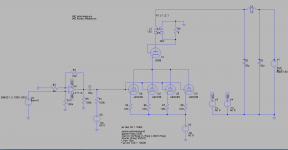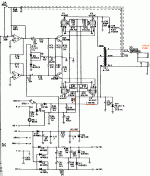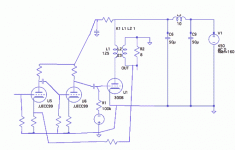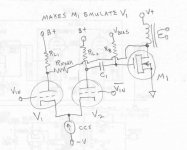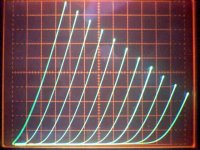I was researching "normal" SET output stages to see if I might want my next amp to be in that family. I found my way to an article on TubeCAD (Class-A2 & Evermore Single-Ended Amplifiers) about A2 that had some interesting permutations regarding driving of the cathode of the 300B rather than the grid. One example shows a mosfet follower acting as a current source on the cathode. I completely misunderstood the intent of that circuit and thought what I was seeing was a gain stage beneath the output triode (like a cascode) and started simulating some versions with ECC99. I stumbled on something interesting - a parallel ECC99 gain stage below the 300B. Below is a version that actually looks like it "works" if one suspends their disbelief regarding simulations. It's intriguing so I'm posting it here for discussion purposes.
Its intriguing because it looks like a way to drive a 300B without a 150Vp-p signal and - if one wants - to achieve some modest grid current without followers driving the grid. You still need many triodes and a negative rail so even if it does "work" it might not be categorically better. So what am I missing? Why wouldn't this work?
Brian
- The ECC99s are biased for about 20mA each and dissipate about 2.5W
- The input swing (at the ECC99 grids) is less than 20Vp-p for full output
- The ECC99s do draw a couple of mA each on positive swings - which an op amp can provide easily but the AC coupling may be a problem
- The 300B is running at 80mA and about 30W at idle
- The negative rail allows the ECC99 to pull the cathode below ground so the 300B draws grid current, in this case through the secondary (for a little feedback) or a direct connection to ground.
- Because it's a cascode the output Z should be a little higher than a normal triode stage, I think about 3.5 ohms in this case (with a 5k:8 OT).
Its intriguing because it looks like a way to drive a 300B without a 150Vp-p signal and - if one wants - to achieve some modest grid current without followers driving the grid. You still need many triodes and a negative rail so even if it does "work" it might not be categorically better. So what am I missing? Why wouldn't this work?
Brian
Attachments
You have thrown on a big pile of bottles to get a higher Gm. That can work.
Of course perhaps the appeal of the 300B (over other types) is its rather flatter Gm curve.
(ECC99 is not the worst of the hot little triodes; does look like it was designed for nice audio.)
300B is not rated for grid current. It sure can take some, but I do not know how much. On test-tone I would add a grid resistor so it could not get over 0.1 Watts steady. In speech/music work I might relax that, though it might make no difference.
The speaker to grid NFB is interesting. However with 300B gain about 4, and OT step-down about 20, I suspect it does about nothing.
The "magic" of a (common cathode) triode is the near-constant Mu, giving near flat gain and low output impedance. Cathode-driven you lose most of that. So why use a costly niche triode? 6L6 EL34 6550 will work in this plan, and these can be run Pentode for more power output.
The R-C coupling WILL be a problem if there is ECC99 grid current and steady tone. (Speech/music, maybe not a problem.) Guitar amps "grid block" when a grid R-C is over-driven. At an extreme the amplifier craps-out until the transient fades; more often you get higher distortion and lower gain.
But why stop there? An NPN has even more Gm for the current. So much that an emitter resistor can make the Gm curve flatter than any tube without obscene drive requirements.
See early MusicMan amplifiers. There were several variants in the first few years of Leo re-entering the amplifier racket. At least two variations of NPN drivers under big pentodes. The NPN only feels the relatively low cathode voltage swing. The tube is isolated from several break-down factors-- it does what the NPN tells it to do. Tube quality is not a big issue (these come from a period when tubes were crap). A small grid bias removes the need for a negative supply.
Of course perhaps the appeal of the 300B (over other types) is its rather flatter Gm curve.
(ECC99 is not the worst of the hot little triodes; does look like it was designed for nice audio.)
300B is not rated for grid current. It sure can take some, but I do not know how much. On test-tone I would add a grid resistor so it could not get over 0.1 Watts steady. In speech/music work I might relax that, though it might make no difference.
The speaker to grid NFB is interesting. However with 300B gain about 4, and OT step-down about 20, I suspect it does about nothing.
The "magic" of a (common cathode) triode is the near-constant Mu, giving near flat gain and low output impedance. Cathode-driven you lose most of that. So why use a costly niche triode? 6L6 EL34 6550 will work in this plan, and these can be run Pentode for more power output.
The R-C coupling WILL be a problem if there is ECC99 grid current and steady tone. (Speech/music, maybe not a problem.) Guitar amps "grid block" when a grid R-C is over-driven. At an extreme the amplifier craps-out until the transient fades; more often you get higher distortion and lower gain.
But why stop there? An NPN has even more Gm for the current. So much that an emitter resistor can make the Gm curve flatter than any tube without obscene drive requirements.
See early MusicMan amplifiers. There were several variants in the first few years of Leo re-entering the amplifier racket. At least two variations of NPN drivers under big pentodes. The NPN only feels the relatively low cathode voltage swing. The tube is isolated from several break-down factors-- it does what the NPN tells it to do. Tube quality is not a big issue (these come from a period when tubes were crap). A small grid bias removes the need for a negative supply.
Attachments
The higher rp of the cascoded 300B might require a transformer with considerably higher primary inductance in order to maintain good LF performance. I figure you are going to at least double rp.
Grid current might be a problem, I don't know.. I've designed a lot of 300B amps over the years but none intended to draw grid current. PRR's concern is valid.
The performance of the lower tube in the cascode is going to probably dominate the distortion signature which will be more pentode like in nature I suspect.
The other concern is whether sufficient linear voltage swing is in practice available at the cathode of the 300B.
Interesting idea, addressing the caveats identified could result in a successful design. Breadboarding seems like a good idea as a next step.
Grid current might be a problem, I don't know.. I've designed a lot of 300B amps over the years but none intended to draw grid current. PRR's concern is valid.
The performance of the lower tube in the cascode is going to probably dominate the distortion signature which will be more pentode like in nature I suspect.
The other concern is whether sufficient linear voltage swing is in practice available at the cathode of the 300B.
Interesting idea, addressing the caveats identified could result in a successful design. Breadboarding seems like a good idea as a next step.
Note that far less vacuum laid-out different will, on paper (and historical experience), give a very excellent amplifier with all-triode sound.
{On third thought, I sure would cathode-resistor bias the 300B.}
Not discouraging your path. Low bottle count is not always the goal. But consider if you are really going "better sound" or just more work/cost.
{On third thought, I sure would cathode-resistor bias the 300B.}
Not discouraging your path. Low bottle count is not always the goal. But consider if you are really going "better sound" or just more work/cost.
Attachments
Last edited:
The original posted cascode version will make the output sound like the bottom device(s). Gm transfer ruling the show. Rather a waste of a 300B I think, could just put a Mosfet in place of that 300B.
Since one can readily emulate the sound of another tube. A small tube could provide some really nice triode curves using the (partial amp) circuit below (V1 inverted triode N Fdbk). A wimpy $4 1E7G (in triode mode at V1) can beat a 300B. Needs some pre-amp stage(s) to complete. M1 could be a Mosfet or a big pentode for some power output. The more gain in the loop, the more accurate the emulation (and lower output Z too).
Since one can readily emulate the sound of another tube. A small tube could provide some really nice triode curves using the (partial amp) circuit below (V1 inverted triode N Fdbk). A wimpy $4 1E7G (in triode mode at V1) can beat a 300B. Needs some pre-amp stage(s) to complete. M1 could be a Mosfet or a big pentode for some power output. The more gain in the loop, the more accurate the emulation (and lower output Z too).
Attachments
Last edited:
Indeed, I find myself trying to use them everywhere.(ECC99 is not the worst of the hot little triodes; does look like it was designed for nice audio.)
I'm not looking to set an operating point in a hard-A2. I just want to get a little more headroom on positive going peaks.300B is not rated for grid current. It sure can take some, but I do not know how much. On test-tone I would add a grid resistor so it could not get over 0.1 Watts steady. In speech/music work I might relax that, though it might make no difference.
It is cool, and lifted straight from John Broskie's blog. As you point out it is less than modest feedback - not even a dB.The speaker to grid NFB is interesting. However with 300B gain about 4, and OT step-down about 20, I suspect it does about nothing.
Well that's an interesting thought. Do you think the sound would be closer to the ECC99's characteristics? The elusive triode sound with pentode power? kevinkr wrote below that the overall tone may already be more pentode like due to the cascode.The "magic" of a (common cathode) triode is the near-constant Mu, giving near flat gain and low output impedance. Cathode-driven you lose most of that. So why use a costly niche triode? 6L6 EL34 6550 will work in this plan, and these can be run Pentode for more power output.
Not something I was aware of, thank you. Is there a target relationship between rp and inductance that I should look for in the future?The higher rp of the cascoded 300B might require a transformer with considerably higher primary inductance in order to maintain good LF performance. I figure you are going to at least double rp.
This is definitely the consensus. As a I mentioned a few lines up, I'm not looking to set an A2 operating point, just a little less distortion on the occasional peak.Grid current might be a problem, I don't know.. I've designed a lot of 300B amps over the years but none intended to draw grid current. PRR's concern is valid.
And that right there probably invalidates the approach for this project, since triode sound was the point.The performance of the lower tube in the cascode is going to probably dominate the distortion signature which will be more pentode like in nature I suspect.
Excellent point and not part of the compromise that I had considered.I have little to add to this discussion, except a warning. PSRR in cascodes is essentially non-existent. Well regulated B+ is an answer to that problem.
The original posted cascode version will make the output sound like the bottom device(s). Gm transfer ruling the show. Rather a waste of a 300B I think, could just put a Mosfet in place of that 300B
Yes, that seems to be the case. My intention was to make a good (or better) 300B amp not to hobble a great output tube.
Yes, that seems to be the case. My intention was to make a good (or better) 300B amp not to hobble a great output tube.
If you want to push into grid current, this is certainly possible, and the ECC99 is a useful tool. You can set one up as a cathode follower fed from a negative bias supply. You can apply negative grid voltage with a pot to the cathode follower from that same bias supply to vary the cathode voltage which is directly connected to the grid of the 300B. This will drive the grid of the 300B well past the 0V line.
While discussing the cascode it is probably best to examine the extremes of the topology first. Take at the bottom a high gm triode bottle, and at significant voltage above it apply an even higher gm MOSFET. The term 'high gm' referring to *DELIVERED* in operation gm, meaning that as implemented at the idle currents used gm is high and even higher...
The lower bottle is going to work into a plate voltage that is effectively constant, and the 'plate curves' at voltage above that of the upper transistor's gate will be effectively horizontal.
The circuit shown with ECC99's operating under a 300B is not that. The signal delivered to the cathode of the 300B is large compared to its DC voltage. The 300B's plate curves will *NOT* be very horizontal, and the ECC99 will experience Miller effects as its plate voltage is moving with signal.
cheers,
Douglas
The lower bottle is going to work into a plate voltage that is effectively constant, and the 'plate curves' at voltage above that of the upper transistor's gate will be effectively horizontal.
The circuit shown with ECC99's operating under a 300B is not that. The signal delivered to the cathode of the 300B is large compared to its DC voltage. The 300B's plate curves will *NOT* be very horizontal, and the ECC99 will experience Miller effects as its plate voltage is moving with signal.
cheers,
Douglas
One problem with "modest" feedback is that it is enough to generate re-entrant distortion but not enough to suppress re-entrant distortion. However, it may reduce output impedance a little which will be useful given that the cascode has seriously increased it.BJosephs said:It is cool, and lifted straight from John Broskie's blog. As you point out it is less than modest feedback - not even a dB.
To get "triode sound" you need to give the triode a high impedance load. The cascode gives the lower triode a low impedance load, so instead of relying on constant mu (usually roughly true) to get low distortion you have to rely on constant gm (usually seriously false). Basically a cascode throws away the linearity of the lower triode. The triode now has a fairly constant anode voltage so it behaves more like a pentode with constant g2.Well that's an interesting thought. Do you think the sound would be closer to the ECC99's characteristics? The elusive triode sound with pentode power?
As others have said, this will not be a '300B' amp: just an amp which happens to use a 300B when cheaper options would work just as well (or badly).
The original posted cascode version will make the output sound like the bottom device(s). Gm transfer ruling the show. Rather a waste of a 300B I think, could just put a Mosfet in place of that 300B.
Since one can readily emulate the sound of another tube. A small tube could provide some really nice triode curves using the (partial amp) circuit below (V1 inverted triode N Fdbk). A wimpy $4 1E7G (in triode mode at V1) can beat a 300B. Needs some pre-amp stage(s) to complete. M1 could be a Mosfet or a big pentode for some power output. The more gain in the loop, the more accurate the emulation (and lower output Z too).
The curve is beautiful. What is the coordinate scale and grid step?
The 1E7G tube is two little 1.5 Watt pentodes in a bottle, wired in parallel as one triode for those curves. Mu is around 10 I see noted in my GE manual.
Here is some data:
https://www.diyaudio.com/forums/tubes-valves/170746-perfectly-linear-triode-7.html#post2255673
Here is some data:
https://www.diyaudio.com/forums/tubes-valves/170746-perfectly-linear-triode-7.html#post2255673
The 1E7G tube is two little 1.5 Watt pentodes in a bottle, wired in parallel as one triode for those curves. Mu is around 10 I see noted in my GE manual.
Here is some data:
https://www.diyaudio.com/forums/tubes-valves/170746-perfectly-linear-triode-7.html#post2255673
Thank you very much! Your work is outstanding!
- Home
- Amplifiers
- Tubes / Valves
- ECC99/300B Cascode Output Stage?
